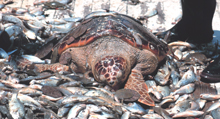When Fishing is Destructive
Coral reefs cover less than one percent of the ocean, but are home to 25 percent of all marine fish species. Humans have been fishing these resources for thousands of years. When there were fewer people, fish stocks were less affected by fishing. As coastal populations grew, desire and need for fish as a source of food and protein also grew. As a result, most reefs have suffered serial depletion of fishes, generally starting with large predators and now including many less desirable species.
Fishing for food and recreation not only removes fish and other organisms, it also alters the ecosystem functions performed by these organisms, leading to fundamental changes in the community. For example, removal of top-level predators may have a cascading effect on the entire ecosystem because fewer fish are left to perform their functions.
Legal, But Damaging, Fishing Techniques

A fishing boat's haul includes the targeted fish species, as well as bycatch: a sea turtle, crabs, and sand dollars that were caught unintentionally. Certain fishing gear, such as turtle excluder devices, can help decrease bycatch. Click image for larger view.
Several fishing techniques damage the ocean floor and marine organisms. Traps set for marine organisms can cause damage to hard corals, soft corals, and sponges. They may also result in bycatch and "ghost fishing" (fishing gear that continues to catch fish even though it has been lost or discarded). Both commercial and recreational fishing contributes to anchor damage on coral reefs. Furthermore, groundings of fishing vessels have significantly damaged certain reefs.
Management efforts have allowed the U.S. to avoid many of the most damaging fishing practices that occur elsewhere in the world. Trawling, for example, can severely damage coral habitats and still occurs in some tropical areas with deeper coral reefs.
Illegal Fishing Techniques
In addition to destructive fishing activities, which are technically legal, illegal techniques also cause severe damage to reefs in many countries. Blast fishers set explosive charges on reefs to stun or kill fish. The resulting explosions kill many species other than the desired fish and gravely damage corals, blowing holes in the reef structure. In a number of countries, the use of cyanide is another popular yet illegal method to catch live reef fish for the seafood and aquarium market. Chlorine bleach and other poisons have also been used. These practices also poison "non-target" species, including corals, and can cause a variety of human health problems.
In the future, greater law enforcement and a better understanding of how fish species move between damaged and protected areas is needed. The underlying socioeconomic factors that drive these destructive fishing practices must also be addressed.
